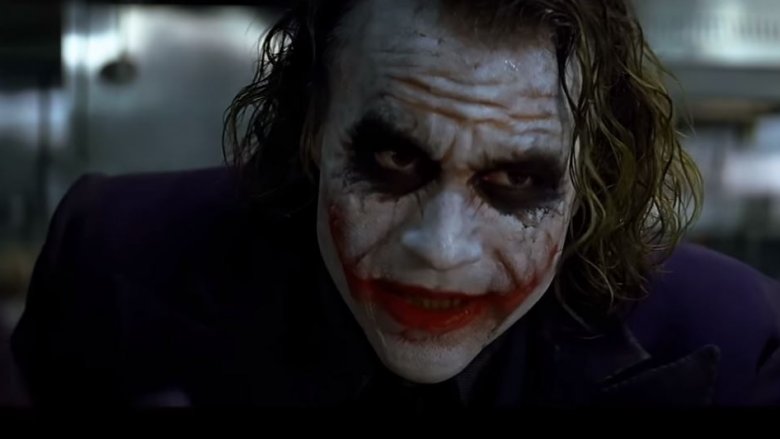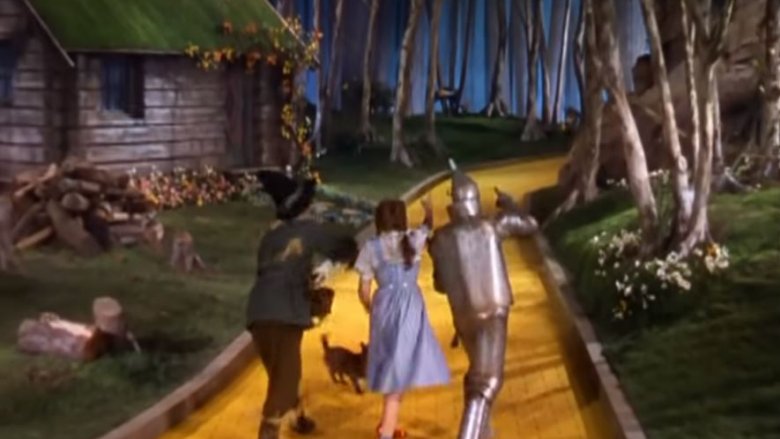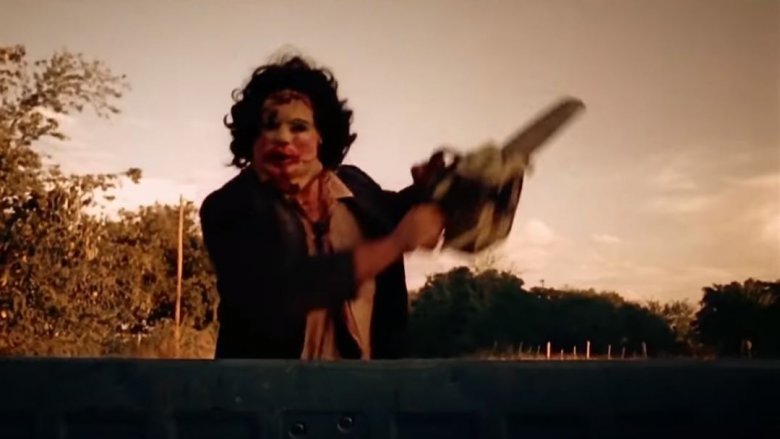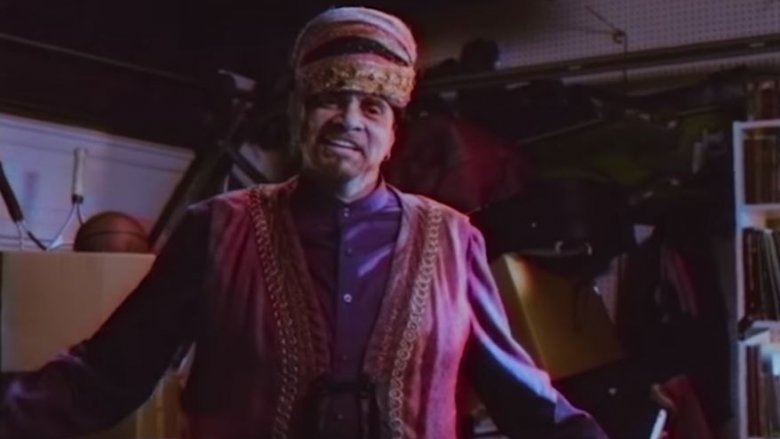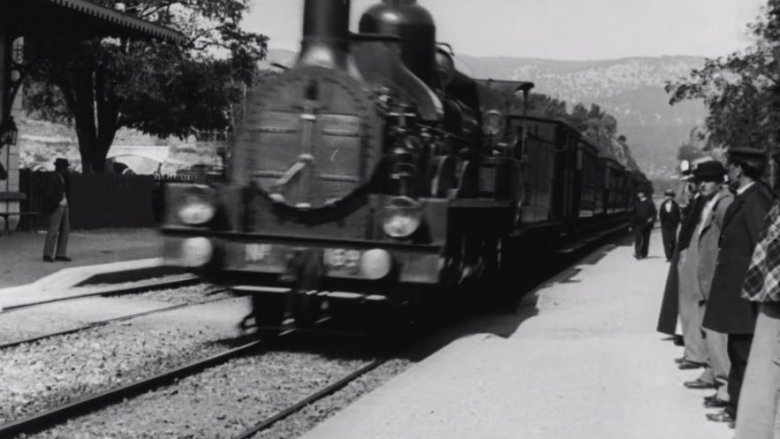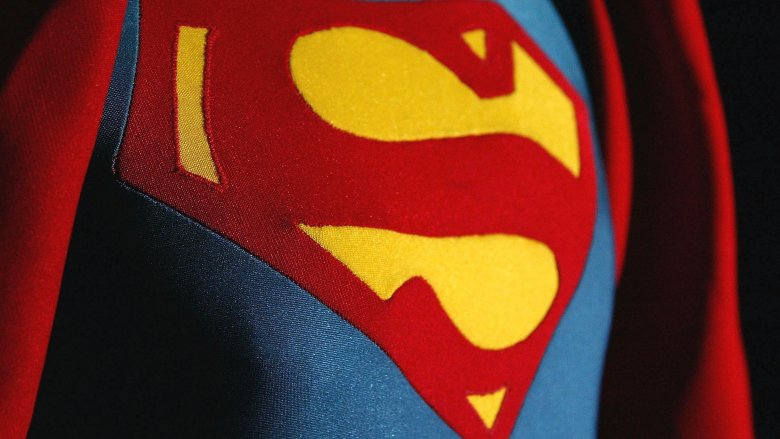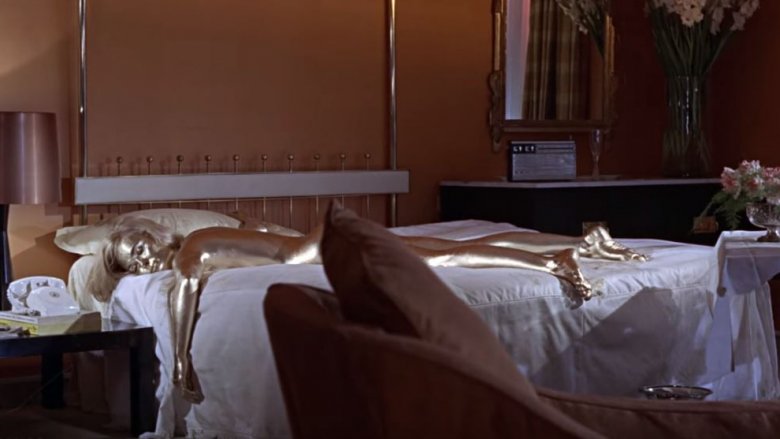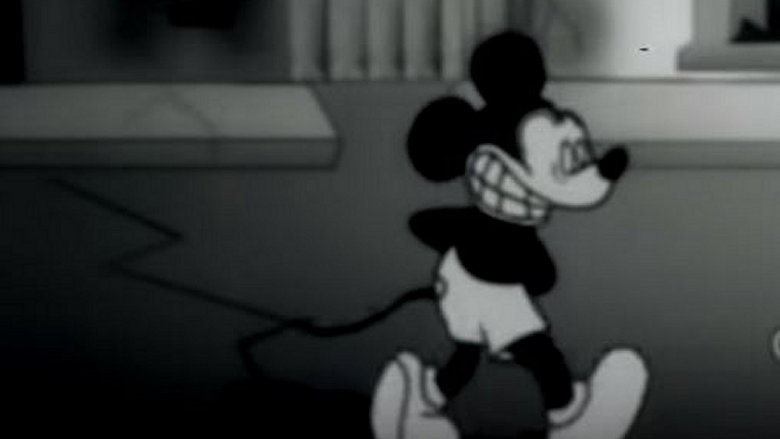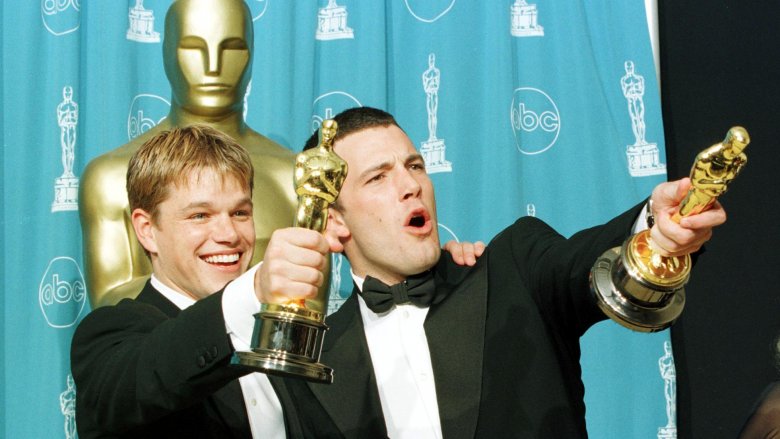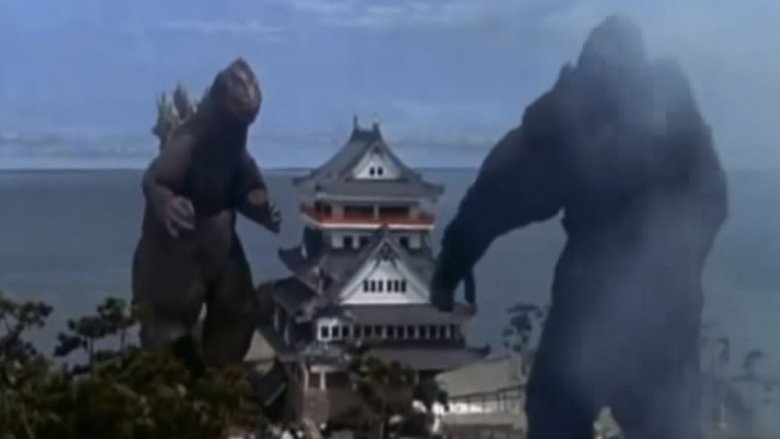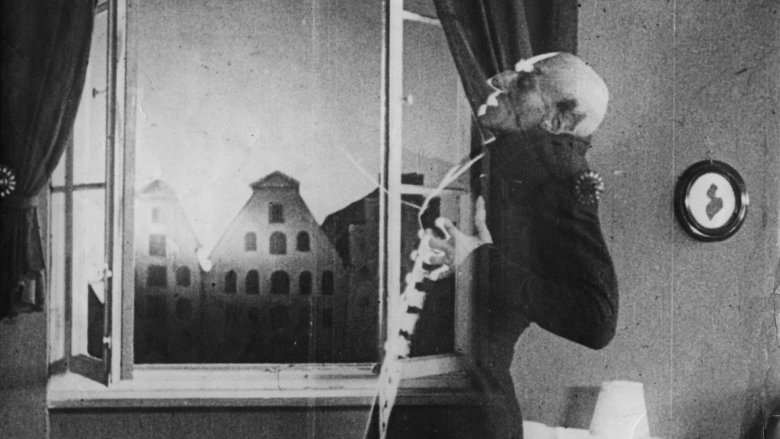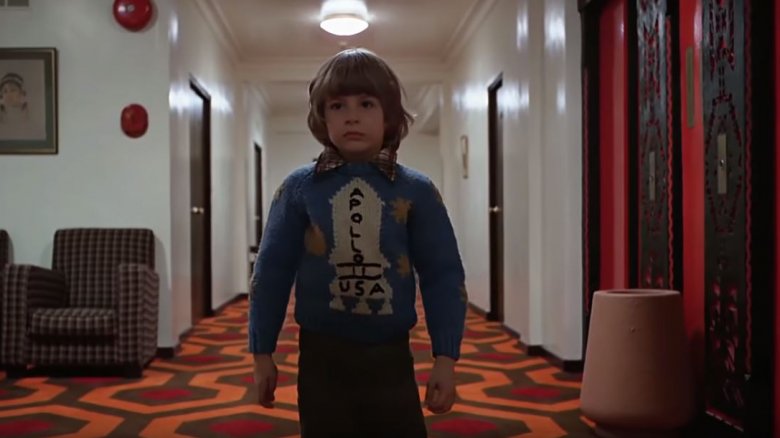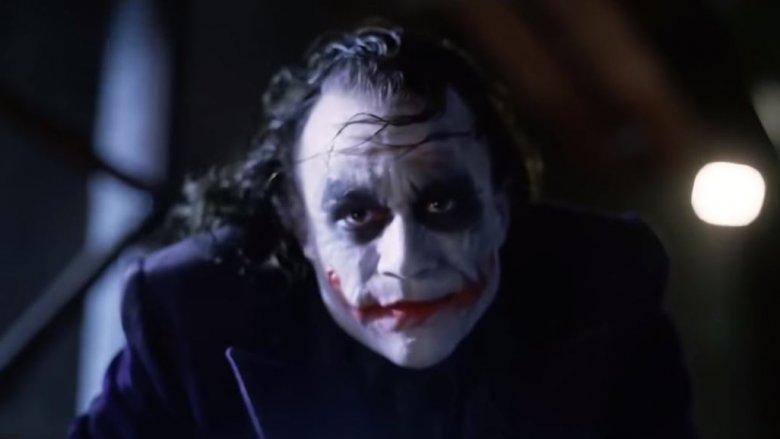Movie Urban Legends Everyone Believed
Great cinema is like a magic trick: The show in front of you is so real, so convincing, that you never stop to think about what crazy stories must have happened on the other side of the camera. Because of this beautiful mystery, the history of cinema is littered with a wide array of wacky urban legends involving everything from magical curses to on-screen manslaughters to subliminal sex messages that were never there. Many of these crazy ideas have been repeated so often and are now so broadly accepted by the public, that people never stop to think about how silly they really are. Other film myths are so intensely "out there" that it's hard to imagine that anyone ever believed them (but they did).
You've heard these stories before. You've maybe even told some of them yourself, from time to time. Now, finally, here is your chance to learn the truth about these movie urban legends.
The hanging munchkin in the Wizard of Oz
There are probably just as many conspiracy theories about The Wizard of Oz as there are bricks in the Yellow Brick Road, according to ABC News. While the way that Pink Floyd's "Dark Side of the Moon" syncs up to the film will never stop being eerie (but coincidental), one urban legend that really needs to be retired is the sad tale of the suicidal munchkin actor who supposedly felt such an intense unrequited crush on Judy Garland that he hanged himself on the movie's set. Generations of viewers have pointed out the swinging shadow of his corpse as proof of this story.
The problem? That shadow is actually a bird, not a munchkin. As Snopes explains, the Oz production was mostly filmed on sound stages. To make the forest seem more outdoorsy, the studio borrowed some avian actors from the zoo, and one of these—either an emu, or a crane—spread its wings during the infamous shot, forever cementing its Academy Award-worthy performance as a dead munchkin silhouette. Don't believe it? Watch some of the more recent, high-def versions of the film, and the proof is right there. In all honesty, though, the notion that the editors would've left a dead actor in the frame was always fairly implausible.
If you or anyone you know is having suicidal thoughts, please call the National Suicide Prevention Lifeline at 1-800-273-TALK (8255).
The Texas Chain Saw Massacre is based on a true story
You know your friend who claims their grandma lived in Texas next to the house of cannibalistic killers who supposedly inspired Tobe Hooper's Texas Chain Saw Massacre? You might've believed Grandma's horrifying story, since both the original film and its 2003 remake advertised themselves with the chilling tagline "inspired by true events," but there's one big snag: that "true story" hogwash was just a marketing stunt.
Sorry to break the fantasy, but Leatherface was fictional, the chainsaw was fictional, the twisted family of cannibals was made up, and none of this (fictional) stuff ever happened in Texas. As Snopes explains, Hooper loosely based the idea of a killer wearing human flesh on a real-life Wisconsin man named Ed Gein. While Gein did murder at least two women, he mostly dug up female corpses, wore their skin, and/or fashioned it into furniture. Some of these deeply disturbing traits made it into the film, but keep in mind, Gein also inspired Norman Bates (Psycho) and Buffalo Bill (Silence of the Lambs). So, if Texas Chain Saw gets to say it's "based on true events," then sure, go for it, Hollywood.
Sinbad was the genie in Shazam
Hey, '90s kids! Do you remember Shazam? No, not the DC Comics superhero, but rather, the family-friendly comedy film starring Sinbad as a magical genie who is reawakened from his slumber just in time to help out some contemporary kids? The answer should be "no" because no such movie ever existed. Nonetheless, a loyal contingent of people will tell you otherwise, swearing up and down that they used to love this (imaginary) film when they were in elementary school. In all honesty, they're probably just misremembering Kazaam, a Shaquille O'Neal flick with an identical storyline, but they're more likely to blame alternate universes or Hollywood cover-ups than the failings of human recollection. Sinbad has always maintained that the film never happened, while confessing to IndieWire that he'd totally flip out if a tape somehow ever got uncovered.
That's probably why on April Fools Day 2017, he and College Humor teamed up to make a "real" version, nearly cracking the internet in half.
The first time people sat in a movie theater, and saw a train... they freaked out!
When new technologies arise, people get weirded out. Seriously, imagine telling someone 30 years ago that they'd have a computer in their pocket? Talk about mind blowing. One of the most popular examples of the rubes of the past getting freaked out by futuristic tech is the old tale that, way back when, an audience sat in a movie theater for a first time ... until a train came rushing at them from the screen so realistically that they ran away screaming!
Amusing as it might be to poke fun at your ancestors, Atlas Obscura points out that there's no record of this incident ever happening. The "train movie" in question was probably a 50-second 1896 French film titled L'Arrivée d'un train en gare de La Ciotat, and most likely, the notion of foolish people going ballistic over a grainy black and white train is rooted in classist attitudes. It's possible that some upper-class snobs would make themselves feel superior by repeating the (fake) story of how those dumb working-class people were scared of the train movie. By 1901, the film The Countryman and the Cinematograph depicted a rural man spazzing out at footage of a train, likely cementing the myth in popular culture.
Beware the Superman Curse
Superman can bounce death rays off his chest, but the men who've played him are as vulnerable as anyone else. For example, there's George Reeves, who portrayed the hero in the 1950s but was later found dead of a self-inflicted gunshot wound. Following that was the equally beloved Christopher Reeve, who in 1995 was left paralyzed by a horseback riding incident. According to Biography, the tragic events that befell these men led some to declare it the "Superman Curse," wherein all who become intimately connected to the character later face some form of personal kryptonite in their real lives. Often, curse believers will also include the misfortunes that occurred in the lives of Superman creators Jerry Siegel and Joe Shuster, as well as the various hardships that impacted supporting actors like Margot Kidder and Marlon Brando.
Well, lots of bad things happen to lots of people, but that doesn't mean it's all magically connected. Frankly, the Superman Curse pretty conveniently ignores all the Superman actors (and writers, artists, and costars) who haven't faced such immense tragedy in their lives, like Henry Cavill, Brandon Routh, Dean Cain, and Tom Welling, probably because these guys don't fit into the tidy narrative. So yeah, it's time to put this fable to bed.
Suffocated by gold
In the classic 007 movie Goldfinger, the villain's secretary Jill Masterson (Shirley Eaton) falls in love with James Bond (Sean Connery), betrays her evil boss, and winds up getting killed for it. She is murdered by being painted gold, an action that causes her death due to what Bond calls "skin suffocation."
Now, characters die in movies all the time, and nobody (except traumatized children) thinks the actors are really being killed. For some reason though, the BBC says that decades of viewers have believed that Shirley Eaton eventually kicked the bucket because all that gold paint poisoned or suffocated her in some way. But no, according to the Smithsonian, Eaton was still alive and writing memoirs by 2014, and furthermore, the whole idea that a person could die from being painted up is yet another myth. Guess what that means? Not only is Shirley Eaton alive, but so is her character! Could Jill Masterson show up in the next Bond movie?
The creepiest Mickey Mouse cartoon ever
If you think Eraserhead is nightmare fuel, try watching the many recreations of "SuicideMouse.avi." According to urban legend, this video is a long-lost Mickey Mouse short from Disney's early days which was allegedly first uncovered when Disney was putting together a new DVD release of old cartoons. Descriptions of the video say it features a weirdly drawn version of the character pensively walking through city streets as freaky piano music jangles in the background. At some point the clip goes black, and when it comes back on the city has transformed into a hellish landscape, Mickey's face distorts into a horrific grimace, and violent screams rage from the speakers, until the clip terminates with a Cyrillic caption that translates to "The sights of Hell bring its viewers back in." The legend says when this video was first discovered, the assistant watching it was so overcome with this glimpse into "Hell" that he killed himself.
A few different recreations of the Suicide Mouse description have popped up online, each claiming to be the original. Creepy as these videos are, though, Bustle explains that none of them hold up to intense scrutiny, as they don't match with the animation and/or drawing styles of Mickey cartoons at that time. While Disney certainly created some bizarre and off-kilter cartoons back then, "Suicide Mouse" wasn't one of them.
If you or anyone you know is having suicidal thoughts, please call the National Suicide Prevention Lifeline at 1-800-273-TALK (8255).
The MGM lion that ate up some burglars
Everybody knows the iconic MGM lion who roars at the camera like there's no tomorrow. According to an oft-quoted urban legend, though, the lion was originally just supposed to stand there and look solemn, proud, and serious ... until two doofus burglars broke into the set. At this point, allegedly, the lion roared — on camera, thankfully! — and also mauled the burglars to death. Some versions of the story go so far as to say that the lion killed his own trainer the next day. It's all total baloney, according to Vintage News. While it's entirely possible that anyone who filmed the iconic lion roar was scared out of their gourds, nobody has ever gotten hurt. This urban legend also conveniently ignores the fact there was never just one MGM lion, as quite a number of big cats have roared their way through the opening titles of these films.
Those subliminal sex messages in Disney films
Most '90s kids remember that strange time in their adolescence when they first rewatched the Disney cartoons of their youth and were shocked to discover hidden sexual references peppered within them. Seriously, in The Lion King, why does dust swirling through the stars spell out "SEX," and why does Aladdin whisper something so creepy as "Good teenagers, take off your clothes"? And hey, what about the bishop in The Little Mermaid? C'mon, Disney!
While animators certainly love to sneak in their little inside jokes, these common theories are demonstrably false, according to Bustle. For example, read the script for Aladdin, and you'll see that he actually whispers, "Good kitty, take off and go." SEX in the sky? Nah. Though you weren't totally imagining those letters, they actually say SFX (as in, special effects). As for the Bishop's infamous popped tent in The Little Mermaid, it's just his knee. Look again, and you'll see it. Or don't because years of jokes have led to Disney digitally removing the knee from later DVD editions.
In fact, the Disney cartoon that actually has R-rated material is The Rescuers, where two frames of the film contain nudity.
The Good Will Hunting script was stolen!
For some reason, a lot of people have ridiculed the fact that Matt Damon and Ben Affleck won an Oscar for their Good Will Hunting screenplay. Despite plenty of evidence that Damon was working on the script for years beforehand, according to Refinery29, conspiracy theorists have argued that they stole the script from William Goldman (Butch Cassidy and the Sundance Kid).
What did Goldman (now deceased) say? Well, he satirized the whole thing on several occasions, but according to his book Which Lie Did I Tell?, his self-proclaimed "total contribution" to the film was about as microscopic as it gets. When Damon and Affleck were first shopping the script around, it contained a bunch of scenes in which the government tried to hire the math kid for covert work. Princess Bride director Rob Reiner advised them to drop the action movie aspects, and Goldman said he told them he agreed with Reiner. Boom, done. Not exactly theft.
In the original Japanese movie, Godzilla won
While the original 1954 Godzilla was a dark allegory for the atomic bomb, the giant radioactive lizard had become pure cheese by the time he faced off with King Kong in 1962. By all rights, Godzilla should've stomped Kong flat, but the original film ends with Kong walking into the water alone and being declared victorious ... an announcement that ignores the fact that Godzilla lives in the water. Honestly, the big reptile probably just figured, "Screw it, I'll take a nap and wait 'til this fool goes back to Skull Island."
Anyhow, since the movie came out, there have long been rumors that Kong's victory was added to the American version, while the original Japanese film has local hero/villain Godzilla winning instead. Not so, says Snopes. While the American edition of the movie did splice in lots of dumb new sequences featuring American actors, the ending was the same in both versions. The Japanese release does include an additional Godzilla roar, which is about all this urban legend has to support it.
Max Schreck was a real vampire
Okay, yes, the idea that the 1922 classic Nosferatu featured an honest-to-god supernatural monster masquerading as a human actor was the plot of the 2000 Academy Award-nominated Shadow of the Vampire, starring Willem Dafoe. However, this storyline was based on a real urban legend that floated around back then, according to the Guardian. In all fairness, it has been almost a century, and no actor has ever pulled off that bloodsucking creepiness on the level of Max Schreck, so there's that. Not to mention, the surname "Schreck" is perfect, since it literally means "to frighten."
Not every version of this conspiracy tale was quite so far-fetched. For example, Nosferatu: A Symphony of Horror reports that back in the 1950s, film critic Ado Kyrou proclaimed it common knowledge that Max Schreck was a cover identity of a still-unknown actor. These days, people are marginally less gullible.
The Shining proves Kubrick faked the Moon landing
Conspiracy theories about the Moon landing being a big ol' hoax go back to ... well, the Moon landing. If you honestly believe NASA filmed the whole thing on a sound stage, that's your business, but probably the wackiest theory ever is this notion that the guy who directed the whole shebang was 2001 mastermind Stanley Kubrick, according to Business Insider. Silly as the concept of Kubrick bossing around Neil and Buzz might be, probably the most intricate fantasy ever developed is the story of how his 1980 film The Shining is supposedly a veiled apology from Kubrick featuring lots of clues. For example, some say Jack Torrance's mental breakdown symbolizes Kubrick's own guilt about faking the Moon landing. Other hints include Danny's Apollo sweater, or that Room 237 is supposed to be the number of the sound stage where Kubrick did the government's dirty work.
Clever as this all is, it's clearly false. Nonetheless, countless people have harassed Kubrick's daughter Vivian about it, to the point where she finally went on Twitter to not only debunk the theory, but to also point out that the whole thing is rather disrespectful to her father's memory.
Heath Ledger killed himself because of the Dark Knight
If there's one thing that every comic fan agrees about, it's that Heath Ledger was absolutely astonishing as the Joker, so good that he completely redefined the character for an entire generation. Ledger threw himself into the part so deeply, and so openly, that an urban legend popped up that his tragic death — caused by an accidental sleeping pill overdose — was the result of him getting so overwhelmed by the Joker's horrifying, chaotic persona that he became sleepless, anxious, and depressed.
In reality, though? Ledger loved playing the Joker, according to his sister Kate. He was having a ball with the role, the Guardian reports, and while his descriptions of struggling with insomnia happened to surface right around the time of his death, the truth is that he had struggled with sleeping problems for many years beforehand. Ledger's method acting approach to the world's most infamous comic book supervillain is certainly something to admire, but the notion that this very role caused his heartbreaking death simply doesn't line up with the facts.
